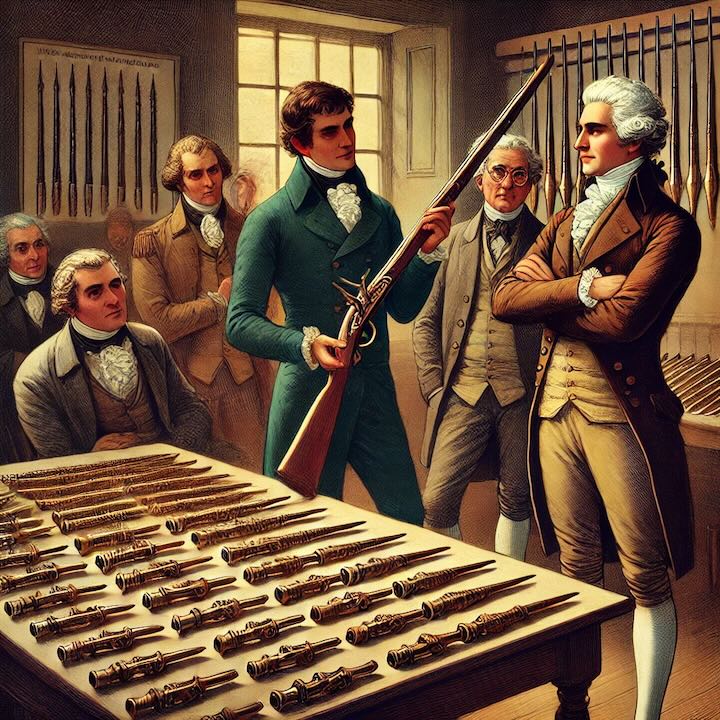
In 1800 Eli Whitney introduced the idea of production with interchangeable parts. This became the basis of the American system of mass production.
In 1800, Eli Whitney introduced the revolutionary concept of manufacturing using interchangeable parts. This innovation would become foundational to the American system of mass production, fundamentally transforming manufacturing processes, labor organization, and ultimately, the economic structure of the United States.
Before Whitney’s breakthrough, manufacturing was highly dependent on skilled craftsmen who painstakingly produced each part of an item by hand. This process meant that no two items were exactly alike, and each one had to be individually assembled and adjusted by hand. Repairs were similarly challenging, as broken parts required custom replacements that had to be crafted to fit the specific item. The labor-intensive and time-consuming nature of this process limited production output and kept costs high, making goods such as firearms and machinery expensive and largely inaccessible to average consumers.
Whitney’s concept of interchangeable parts was simple but transformative: rather than creating unique parts for each item, parts would be standardized and produced in large quantities so they could fit into any assembly of that item. For instance, each part of a musket would be made to identical specifications, enabling it to be easily swapped out with any other identical part if damaged. Whitney initially pitched this idea to the U.S. government, which was searching for efficient ways to arm its military forces. He famously secured a contract to produce 10,000 muskets for the U.S. Army, committing to manufacture each musket with interchangeable parts, thus drastically reducing the need for skilled labor and time-consuming adjustments.
However, implementing interchangeable parts was not without its challenges. Manufacturing technology in Whitney’s time was not as advanced as it would become in later decades, making it difficult to produce parts with the precise uniformity required for true interchangeability. Early attempts at achieving this were met with technical difficulties, but Whitney’s vision inspired a wave of innovation that would steadily improve machine tools and manufacturing processes. Over the following decades, advancements in precision engineering and mechanized production equipment began to make true interchangeability feasible on a large scale.
By the mid-19th century, Whitney’s ideas had set the stage for the American system of manufacturing, an approach that emphasized efficiency, standardization, and mechanization. This system enabled manufacturers to produce goods in large quantities at lower costs, meeting the demands of a rapidly growing market. Factories designed around mass production principles could employ semi-skilled labor rather than relying on artisans, thereby reducing labor costs and increasing production rates. This shift had profound social and economic implications, as it created numerous jobs and made a wide variety of goods more affordable and accessible to a broader population.
The ripple effects of Whitney’s idea extended well beyond firearms. Industries such as textiles, agriculture, and even emerging technologies like the telegraph quickly adopted the principles of mass production and interchangeability. By the early 20th century, these principles would be further refined and expanded by figures like Henry Ford, whose assembly line for automobiles exemplified the efficiency of standardized mass production. Ford’s assembly line, inspired by Whitney’s interchangeable parts, drastically cut production time and costs, making cars affordable for the middle class and symbolizing the full maturation of the American system of mass production.
 >
>